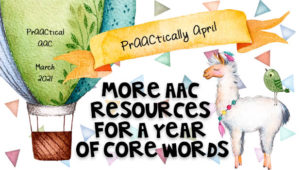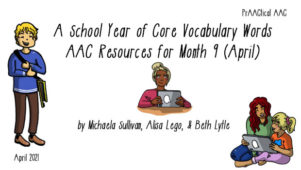TELL ME About It: AAC Learning with ‘Max’s Breakfast’
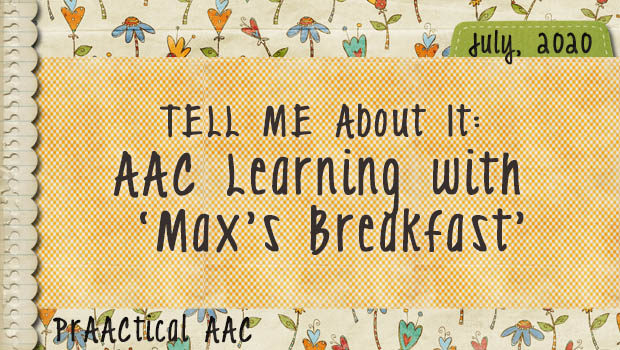
Welcome back to another installment of TELL ME About It, guest authored by Jeanna Antrim and Maggie Judson. Maggie and Jeanna are speech-language pathologists who work in the Assistive Technology Department for the Belleville Area Special Services Cooperative (BASSC) in southern Illinois. They are AT/AAC facilitators and provide evaluations, direct therapy, consultations, and trainings with school teams. In this series, they discuss how they support preschool teachers who are implementing the TELL ME program with their young students.
Today, they walk us through the ways that they facilitate AAC use while focusing on the book ‘Max’s Breakfast’ Don’t miss their Lesson Plan, video demonstrations, and other resources at the end of the post.
You can see their previous posts in the TELL ME About It series below.
- If You’re Angry and You Know It
- The Lunch Box Surprise
- Come Out and Play, Little Mouse
- No, David
- Go Away Big Green Monster
- What Do You Like?
- Here Are My Hands
- From Head to Toe
- I Went Walking
- Brown Bear, Brown Bear
- TELL ME AAC Literacy Kits
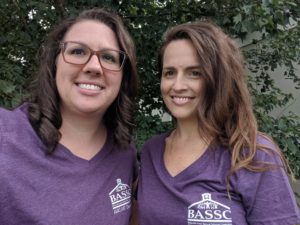
TELL ME About It: AAC Learning with Max’s Breakfast
The eleventh (and final!) book in the TELL ME program (Teaching Early Language and Literacy through Multimodal Expression) is ‘Max’s Breakfast’! This book is a super cute, easy-to-read, relatable story for students. Relatable because what child at one time or another, has really, really disliked something on their plate (it seems to happen daily in our houses!)?! We also love this book because it lends itself to being easily retold with a story map while using those oh so important core words! 
Check out below for the book focus of “Max’s Breakfast”:
Book Focus: Max’s Breakfast
➔ Core Words (BOW WOW Words): ALL GONE, DOWN, GET, ON, WHERE
➔ Additional Words (Tiger Talk Words): different, there
➔ Concept Vocabulary: food
➔ Special Letter: u
➔ Book Concept: pictures vs. words; review all concepts
TELL ME About Writing: One crucial aspect of predictable chart writing is the re-reading portion. This activity provides students with the opportunity to practice reading the words silently in their head and following along and discriminating between words. It also allows for practice identifying other writing aspects, such as the special letter, capital letters, or punctuation.
1. Before Writing: First, review and find those core words on the student’s AAC system. Then, introduce the title for the predictable chart – “The title of our chart is ‘WHERE is The Egg?’ Let’s talk about the DIFFERENT places that we could hide the egg.” Brainstorm various ideas about WHERE to hide an egg (under a napkin, ON someone else’s plate, DOWN ON the floor with the dog!) before engaging in the writing activity.
2. Writing: Hand out each student’s PowerPoint book and have them practice re-reading each of the sentences. Then, go back through the book and find the special letter ‘u.’ After finding the special letter, support the students to go on a core word hunt while flipping through their book.
➔ It is UP on the table.
➔ It is DOWN by the shoe.
➔ It is THERE under the chair.
3. After Writing: As tradition warrants, wrap up your writing activity by singing the letter song. Then, do a follow-up activity of a crayon rub to continue the focus on the special letter ‘u’. 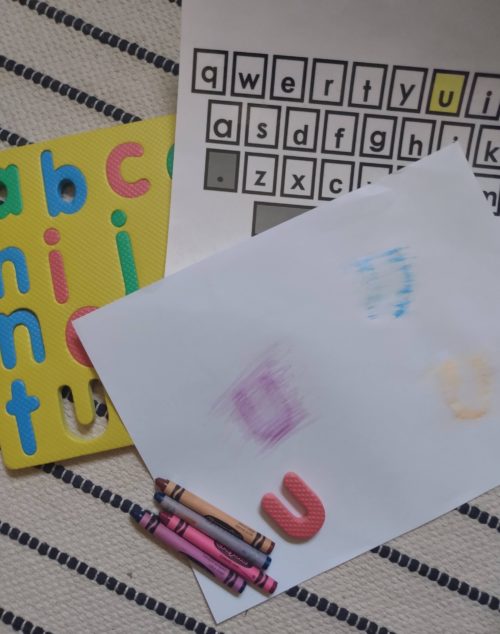
TELL ME More: Below are some specific ideas on how to implement “Max’s Breakfast” in your therapy sessions and classrooms TELL ME-style!
● Activity – Outside Time!
Our children and students love to play outside. And why shouldn’t they! With so many different activities ranging from nature walks, playing kickball, swinging, or playing with bubbles and chalk, there is something to pique any child’s interest. And with interest and enjoyment comes a motivation to communicate! Whether it’s making a request, commenting on how much fun they are having, or letting you know they are finished with the activity. And there are multiple, easy ways to have access to communication while outside. See below in the following section for some fun ideas. In addition to those suggestions, a communication board playground sign is always an excellent alternative. One of the programs in our cooperative implemented the use of this last school year and it was a huge hit. Check out @ahacommunication on Instagram to learn more! 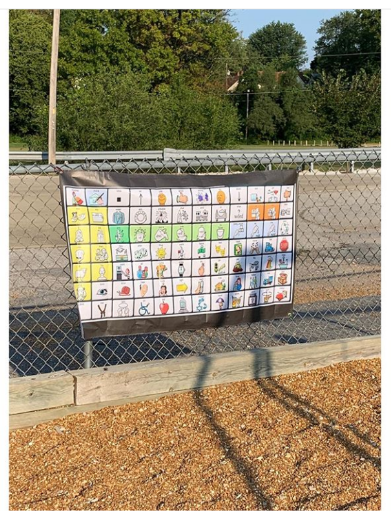
➔ I want to go UP and DOWN!
➔ You GET to go now.
➔ WHERE is the butterfly going?
➔ Oh no, the bubbles are ALL GONE!
➔ THERE is the chalk! Look, all the colors are DIFFERENT.
● Teaching Strategy – AAC On the Go!
Sometimes speech-generating devices (SGDs) can be cumbersome to take outside, hard to see in the daylight, or difficult to protect (hello water, sand, and dirt!)! Well, have no fear, there are so many options available as suitable alternatives no matter what your scenario! Some ideas that our staff and families use are:
➢ Ziploc Bag-This provides water proof protection during water play.
➢ Low tech manual communication boards-Whether laminated, in a page protector, or on plain paper, these boards are an inexpensive, reproducible alternative to provide communication supports on-the-go.
➢ Mini communication boards- These can be hooked on a keychain, lanyard, or attached to a fanny pack!
➢ Magnet communication boards- We take advantage of Shutterfly’s app deals and create magnet manual communication boards. These have proven to be very durable and easy to slip into a bag or purse! And they stick on anything metal – the outside of the door, a bicycle, parts of a playground, even on the car!
➢ Iron-on communication boards- What’s more fun than wearing or having a communication board adhered to your personal items?! We’ve done this on drawstring bags, scarfs, shirts, blankets, and aprons, just to name a few!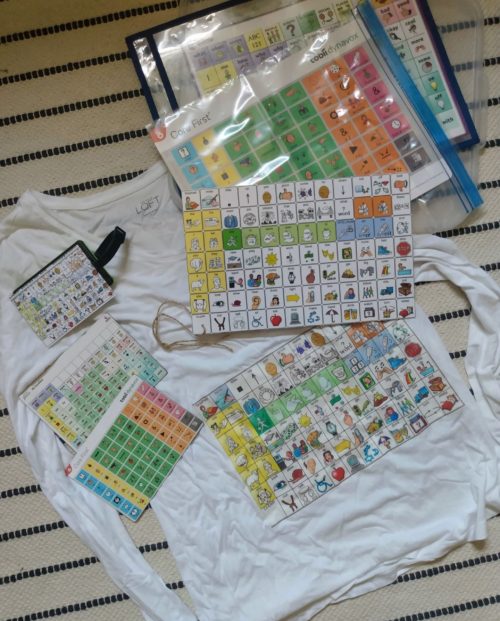
● Implementation Tip – Where to Find Supports!
Below are some of our favorite spots to find communication and literacy supports:
1) Saltillo – https://saltillo.comCheck out their ‘Chat Corner’. There you will find tons of supports for how to provide aided language input, as well as how to choose core words for a particular activity and how to target core vocabulary in different environments. They also have an annual calendar with even more communication supports! You can find the 2020 calendar here!
2) PRC – https://www.prentrom.com/
Check out the ‘Caregiver Resources’ section for supports and information to share with families regarding AAC, as well as free monthly downloadable activities to use with their different vocabularies. They also provide a Literacy Planner on an annual basis. Find the 2020 Literacy Planner here!
3) AAC Language Lab – https://aaclanguagelab.com/
This website offers so many activities and lesson plans for implementation! You
can also download (free) communication boards for both Saltillo and PRC vocabularies.
4) AssistiveWare – https://www.assistiveware.com/
Check out their Assistive Core Word Classroom for so many implementation tips and resources. They have great lesson plans for targeting core vocabulary words with a core word of the week approach and a per activity words approach. You can download manual communication boards from their site for free, as well!
5) Tobii-Dynavox – https://www.tobiidynavox.com/en-us/
We recommend creating a mytobiidynavox account – this will provide you access to resources ranging from myth-buster handouts, basics of AAC, tips for implementation, and lesson plans/books for targeting core vocabulary words. You can also download manual communication boards from their site for free!
6) Tarheel Reader – https://tarheelreader.org/
This is a fabulous, free resource where you can obtain access to short books on a variety of topics that have simple text, core words, and repetitive lines. Which by now we know are all great features for a shared reading experience! If you create an account (which you should!) you then have the ability to write your own books with your students or child.
7) Literacy for All – http://literacyforallinstruction.ca/
This website is an invaluable tool for learning about all things reading and writing, including providing shared reading and writing activities and opportunities for students with complex communication needs.
8) Project Core – http://www.project-core.com/about-project-core/
Another must-use resource that provides all the information for implementing AAC and literacy activities for students with complex communication needs!
9) BASSC YouTube Channel – https://c/basscaac
Our YouTube Channel offers videos of us providing aided language input while reading various books. We also have step-by-step demonstrations for downloading device emulators, making mini communication boards, creating iron-on communication board projects, and showing how we use various mid-tech communication devices.
And of course, a no-fail way to find resources and information is to search for a desired topic on PrAACtical AAC’s website. This is always our first stop! We recommend that you sign-up for email alerts so you never miss a post!
● Aided Language Input Tip – Demonstrate Different Communication Functions!
If we want our children and students to become efficient and effective communicators with a robust vocabulary, then we have to demonstrate how to communicate using different communicative functions across environments. One way to accomplish this is by implementing aided language input for various purposes throughout the day. Some examples of communicative functions that you can provide aided language input for include: commenting, protesting, asking/answering questions, giving commands, labeling, making statements, greeting, sharing/showing, requesting, and joking/teasing. By providing aided language input for these different functions across settings throughout the day, we show our children and students how to become great communicators!
➔ I need to GET my pencil for my morning work. (Statement-Independent Work Time)
➔ Can you GET us a book to read? (Ask Question-Reading Time)
➔ GET more juice. (Command-Snack/Lunch Time)
➔ I want to GET on the bus. (Request-Departure Time)
➔ I think you are telling me to GET away! (Protest-Any Time!)
➔ Gonna GET you! (Tease-Play Time)
● Goal Ideas – Providing shared reading and writing opportunities directly relates to IEP goals, as these activities align with various core standards. Here are some examples you may find applicable:
○ CCSS.ELA-Literacy.W.K.6: With guidance and support from adults, explore a variety of digital tools to produce and publish writing, including in collaboration with peers.
○ CCSS.ELA-Literacy.W.1.1: Write opinion pieces in which they introduce the topic or name the book they are writing about, state an opinion, supply a reason for the opinion and provide some sense of closure.
———————————————————————————————————————
RESOURCES and REFERENCES
- You can purchase the TELL ME manual from the Attainment Company or from ASHA.
- You can learn more about the program by watching the webinar TELL ME: AAC for the Preschool Classroom presented by Dr. Carole Zangari, available from Saltillo (bit.ly/2RNpykn).
You can find our Lesson Planning form for “Max’s Breakfast” and a blank form here.
Follow us on Instagram @basscAAC and subscribe to our YouTube channel (basscAAC) for more AAC implementation ideas!
Check out the videos of us reading the book “Max’s Breakfast” while providing aided language input.
WordPower 88
LAMP Words for Life
Follow us on Instagram @basscAAC and subscribe to our YouTube channel (basscAAC) for more AAC implementation ideas!
:::::::::::::::::::::::::::::::::::::::::::::::::::::::::::::::::::::::::::::
This may be the last book in the series, but they have much more to share. Maggie and Jeanna will be back next month with additional tips and resources for implementing the TELL ME program. Stay tuned!
Filed under: Featured Posts, PrAACtical Thinking
Tagged With: core vocabulary, TELL ME
This post was written by Carole Zangari


